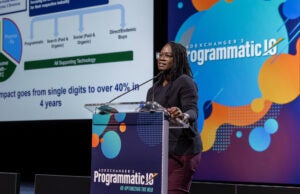 “Data-Driven Thinking” is written by members of the media community and contains fresh ideas on the digital revolution in media.
“Data-Driven Thinking” is written by members of the media community and contains fresh ideas on the digital revolution in media.
Today’s column is written by Andrew Casale, vice president of strategy at Casale Media Inc.
One of programmatic’s key promises has always been that it would disrupt the ad networks’ lock on inventory supply in the market. Through programmatic, advertisers gain the opportunity to take full control over a scaled buy, and to conduct it on their own terms and with their own data.
But to date, a disproportionate share of spending in the programmatic market has come from ad networks, regardless of the fact that the industry laid the groundwork years ago. It’s a reality that was highlighted at the recent OMMA RTB conference by Jay Seideman, Microsoft’s senior director of US targeting and exchange.
What happened to the disruptive promise of programmatic? I tasked one of our RTB marketplace analysts to find out. Checking Seideman’s observation against our exchange’s buyer-level data, what we found both validated his comments and revealed a surprising silver lining.
For every bid submitted to the exchange, we identified the bid’s seat and the seat owner – that is, the underlying entity that’s actually spending the money. Then we analyzed the top 200 seats, across all demand-side platforms and organized them into categories. It turns out managed services, which would include the networks, holds the largest market share of programmatic buying activity, at 47% as of the fourth quarter of 2013.
But here is where the numbers get more interesting. When we look at changes in programmatic market share since 2012, managed services’ share of the market has actually shrunk by 18%. On the flip side, trading desks are gaining market share, with a 22% increase in 2013, compared to 18% the year before. That should not surprise most people who follow the market.
But the real story is the rise in spending from seats owned directly by brand marketers. That share jumped dramatically in this period, from 3% in 2012 to 11% in 2013. Marketer-managed seats more than tripled the share of bids placed year-over-year. Here’s the full chart:
| Seat Type | Share of spend in Q4 2012 | Share of spend in Q4 2013 | YoY Change |
| Agency (non-trading desk) |
14% |
14% |
Flat |
| Managed service / Network |
57% |
47% |
-18% |
| Marketer |
3% |
11% |
+267% |
| Other |
5% |
3% |
-40% |
| Publisher audience extension |
3% |
3% |
Flat |
| Trading Desk |
18% |
22% |
+22% |
In other words, the promise of programmatic is bearing fruit. Marketers are taking control over their buys and presumably tailoring them to the distinct needs of their brands, either directly through self-serve, or through consultation with their agency or agency trading desk.
The motor powering the rise of self-serve programmatic is a perfectly logical one. When a brand starts getting involved with a new way of doing business, such as programmatic buying, it’s going to want a partner to illuminate the ins and outs, a managed service in this case. Through the natural course of doing business, the brand will reach an impasse: It decides this business endeavor isn’t worth the investment and throws it out the door, or it instead chooses to take off the training wheels and make a serious go of it, either through an extended commitment to their current partner or with more custom solutions tailored to their needs.
Clearly, we’re looking at a tremendous vote of confidence in programmatic among brands. The overwhelming increase in brands taking the self-serve route demonstrates the value they’ve seen in programmatic and the commitment they’re willing to take with it.
This rise of self-serve is positive for everybody on both the buy and sell sides because it brings more parties into the ecosystem and facilitates a more balanced market in general.
There are, of course, a few cautions to consider. For brands, it’s important to consider whether the budget supports a self-serve approach, if the data is sufficient to make it worthwhile, or whether they have they have enough experience in programmatic to justify going at it alone.
For publishers, the investment on the buy side needs to mirror the supply side. These are especially sophisticated deals, which can be incredibly productive for the publisher, but only when paired with an equally advanced strategy. This means that as self-serve programmatic increases its market share, publishers need to invest in programmatic skill, whether developing that skill in-house or through their SSP or exchange partner.
Programmatic has arrived, and the demand among brands to take matters into their own hands proves it. Newer innovations in programmatic, such as Deal ID and preferred auctions, are aimed at giving marketers and agencies even more advantages in the exchange.
I expect the trend of marketers and agencies gaining more control of exchange inventory to accelerate this year, and even more marketer-managed seats in 2014.
Follow Casale Media (@casalemedia) and AdExchanger (@adexchanger) on Twitter.













